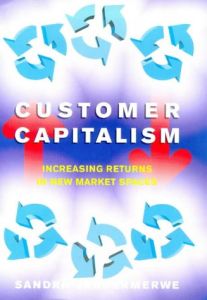Join getAbstract to access the summary!

Join getAbstract to access the summary!
Sandra Vandermerwe
Customer Capitalism
Increasing Returns in New Market Spaces
Nicholas Brealey Publishing, 1999
What's inside?
Sure the dot-com bubble has burst, but before you become too complacent in your brick-and-mortar office, consider this: Of the companies included in the 1970 Fortune 500, only about 30% still exist.
Recommendation
The death of the New Economy has been greatly exaggerated. That’s the message at the heart of Sandra Vandermerwe’s new book. While the heady valuations of the late ’90s are history, the fundamental changes that technology inspired during that time are here to stay. With that in mind, Vandermerwe presents analyses of tools that business leaders need to survive into the 21st century. The most insightful of these is a breakdown of customer feedback loops and how they can be harnessed to lock in business. The book can’t avoid many of the shortcomings that pervade most New Economy literature, like the tendency to advise readers to remake their businesses in anticipation of future customer needs, without commenting on how exactly that can be achieved. Nevertheless, if you’re a manager who suspects that the innovations of the past decade might still play a key role in the growth of business, getAbstract recommends this book to you.
Summary
About the Author
Sandra Vandermerwe, a management expert, holds the Chair of Management and is Professor of International Marketing and Services at Imperial College in London. She has consulted and conducted research on behalf of many business organizations. She won the European Marketing Case of the Year award several times, and has written two other business books.
















Comment on this summary